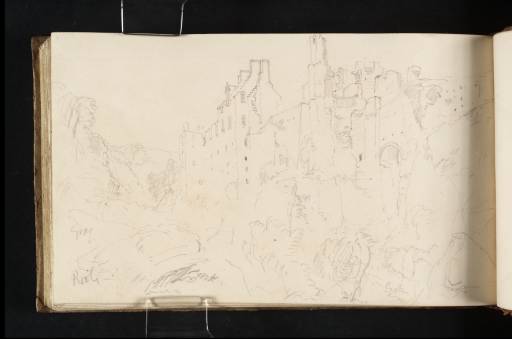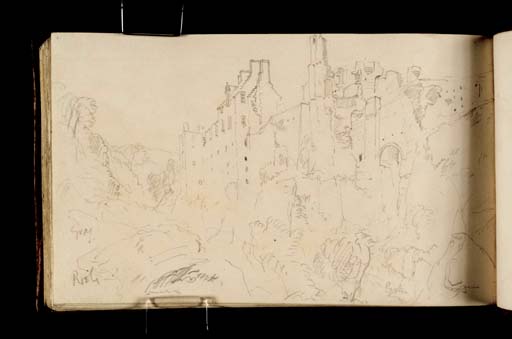Joseph Mallord William Turner Roslin Castle 1818
Image 1 of 2
Joseph Mallord William Turner,
Roslin Castle
1818
Joseph Mallord William Turner 1775–1851
Folio 78 Verso:
Roslin Castle 1818
D13713
Turner Bequest CLXVII 70a
Turner Bequest CLXVII 70a
Pencil on white wove paper, 112 x 186 mm
Inscribed in pencil by Turner ‘Gray | Rosln’ bottom left; ‘Esk’ bottom right
Inscribed in pencil by Turner ‘Gray | Rosln’ bottom left; ‘Esk’ bottom right
Accepted by the nation as part of the Turner Bequest 1856
Exhibition history
2002
Rosslyn: Country of Painter and Poet, National Gallery of Scotland, Edinburgh 11 April to 7 July 2002.
References
1909
A.J. Finberg, A Complete Inventory of the Drawings of the Turner Bequest, London 1909, vol.I, p.487, CLXVII 70a, as ‘Rosyln Castle.’.
2002
Helen Rosslyn and Angelo Maggi, Rosslyn: Country of Painter and Poet, National Gallery of Scotland, exhibition catalogue, Edinburgh 2002, pp.42 illustrated, 43.
As Turner’s inscriptions indicate this sketch shows ‘Roslyn’ (or Roslin) Castle from the ‘Esk’ river. The view looks up towards the south-east corner of the castle where an arched bridge crosses a ditch to the ruined gatehouse (see Edinburgh, 1818 sketchbook Tate D13501; Turner Bequest CLXVI 27). This is one of the most detailed sketches of Roslin Castle from this tour with special attention paid to the architecture some parts of which ‘still stand firm in all their former strength, while others, broken and shattered, impend over and threaten the spectator’.1
The juxtaposition of this sketch and a pencil and grey wash drawing by Joseph Farington of 1788 (private collection) in an exhibition catalogue of 2002 reveals a striking similarly between the two pictures.2 The castle is viewed from the same spot in both cases and Turner arranged his composition in an identical fashion on a sheet of paper with the same proportions as Farington, albeit smaller. Although Turner does not include the river in his sketch, he does note its presence and position with the note ‘Esk’ at the bottom of the sheet.
As the author Helen Rosslyn noted, Farington had directed Turner to ‘particular picturesque places’ before his 1801 tour of Scotland which she surmises ‘must have included Rosslyn’.3 The two artists’ close association makes it very likely that Turner saw Farington’s drawing before he made the current sketch of Roslin Castle, which may have been intended as a recreation of the view. Comparison of the two works side by side reveals that the castle disintegrated between 1788 and 1818, with one side of the gatehouse collapsing. The river banks also became more overgrown in this period, as is evinced by the thick foliage in Turner’s drawing, especially considering that it was made in October, while Farington’s was made, according to his inscription, in ‘July’.
Thomas Ardill
March 2008
Provincial Antiquities and Picturesque Scenery of Scotland with Descriptive Illustrations by Sir Walter Scott, Bart., Vol.II, London and Edinburgh 1826, p.[127]).
How to cite
Thomas Ardill, ‘Roslin Castle 1818 by Joseph Mallord William Turner’, catalogue entry, March 2008, in David Blayney Brown (ed.), J.M.W. Turner: Sketchbooks, Drawings and Watercolours, Tate Research Publication, December 2012, https://www


